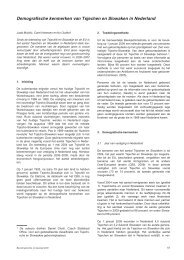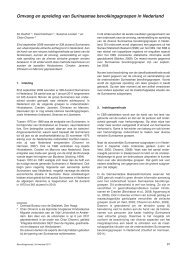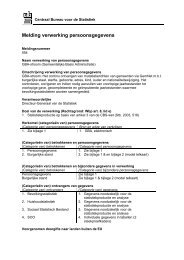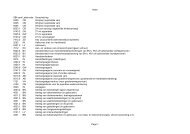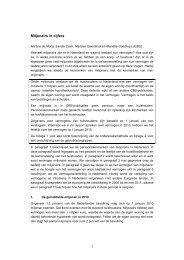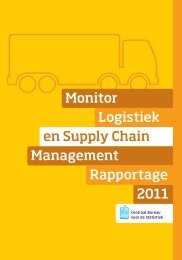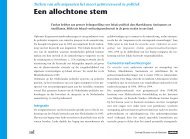Internationalisation monitor 2012 - CBS
Internationalisation monitor 2012 - CBS
Internationalisation monitor 2012 - CBS
Create successful ePaper yourself
Turn your PDF publications into a flip-book with our unique Google optimized e-Paper software.
14 Statistics Netherlands<br />
at the technology level of re-exported products, it turns out that Dutch re-exports mainly<br />
consist of high-tech products. This is the case for re-exports going to European countries,<br />
as well as re-exported products going to the US or BRIC (except China). Alternatively, the<br />
technology level of Dutch manufactured products is somewhat lower. The importance of<br />
agricultural products in Dutch exports plays an important role in this respect.<br />
Although the majority of Dutch trade is with other European countries, imports<br />
coming from BRIC-countries continue to grow. Since 1996, imports from BRIC-countries<br />
quadrupled in size. In 2011, China was the third most important source of Dutch imports.<br />
BRIC countries are rapidly growing, also in terms of economic power, providing growth<br />
potential for Dutch exporters, which are somewhat lagging behind in entering these<br />
markets (compared to other EU-countries). By looking at the characteristics of enterprises<br />
that do trade with BRIC countries, chapter 2 makes apparent which enterprises fill such<br />
potential. It turns out that BRIC traders are often medium to large sized firms, active in<br />
two-way-trade, foreign owned and engaged in R&D. Also, BRIC-trade is associated with<br />
higher productivity, indicating that only the more productive firms are able to overcome<br />
trade barriers, costs and uncertainty.<br />
Besides international trade in goods, trade in services are also an important part of international<br />
trade (see chapters 3 and 11). Services exports account for approximately 20 percent<br />
of total exports, which is a percentage that has remained stable since the mid-90s. Trade<br />
in services was less affected by the economic crisis than trade in goods, but still services<br />
exports declined significantly. Imports of services continued to grow during the crisis,<br />
although relatively modest.<br />
In the 2004–2011 period, the category other business services was by far the largest in<br />
Dutch services imports and exports. Although this category is extremely diverse, approximately<br />
50 percent could be ascribed to services trade between affiliated enterprises. For<br />
imports as well as exports of services, the second and third most important services<br />
traded were transportation, and royalties and license fees in 2011.<br />
In 2011, the United States is the largest provider of services to the Netherlands, while<br />
Ireland was the most important destination for Dutch services exports. In terms of Dutch<br />
imports of services, Ireland was also an important partner country. Singapore is the largest<br />
upcoming trade partner in terms of imports and Poland in terms of services exports.<br />
The share of foreign controlled enterprises in the private sector has continued to grow<br />
over the years. In 2010, foreign controlled enterprises generated 15 percent of Dutch GDP,<br />
employed 804 thousand people and accounted for almost a quarter of private sector<br />
investments (see chapter 4 and 12). But Dutch firms abroad were severely affected by<br />
the economic crisis and saw their turnover decrease by 25 percent in 2009. However,<br />
in 2010 this turnover returned to the level before the crisis. Despite the crisis, the number<br />
of employees at Dutch firms abroad did not decrease much. In spite of the economic<br />
downturn, the number of Dutch controlled enterprises increased substantially, which may





